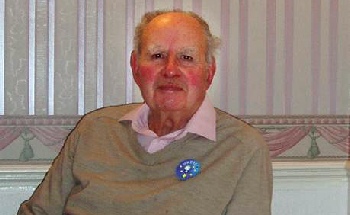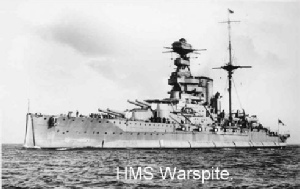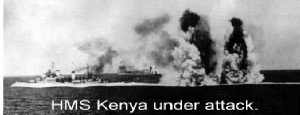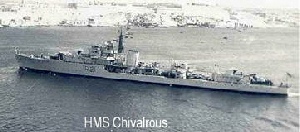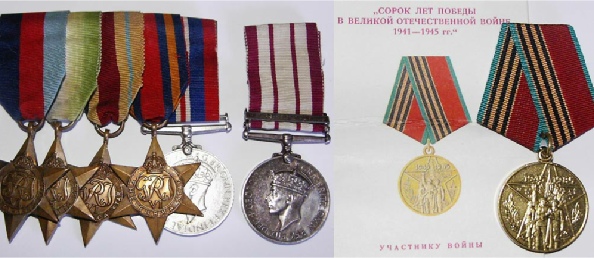Bert said that as they passed through London, on a troop train, the air raid balloons were already flying. Their destination was Portsmouth where Bert was billeted on HMS Warspite.
The next day war was declared and Bert’s pay went from a boy’s to a man’s i.e. 50 pence to £2 and 50 pence, he was a rich man. As an electrical Artificer Bert’s next posting was to stand by the Fiji class cruiser, HMS Kenya building at Alexander Stephens yard on the Clyde at Glasgow. Bert maintained the gyros and asdic equipment; his action station post being three decks down in the bow with of course locked hatches above him. Later when degaussing became necessary he had this equipment to maintain. He said it was at first copper bars taking 200 amps later multicore cables taking a few amps were fitted around the upper deck. After work up around Scapa the ship’s first task was convoy duty to Freetown in Sierra Leone. His run ashore there introduced him to topless young ladies with the younger shunning all garments. He says that he hurried back to the ship?
Kenya continued to be well worked being involved in the Bismarck action and further convoys. This included 4 Russian convoys and raids on the Norwegian coast. On the 4th Russian convoy General Gromoff boarded the ship and in honour of the revolution the hammer and sickle were flown at the mast. Bert reckoned this was a one off event.
The Russian convoys had their own horror; no life jackets were issued as three minutes in the water meant death. Bert said that most rescued lost their limbs. The problem of ice accumulation at night meant all night chipping ice from the upper decks, in spite of this work Bert saw a minesweeper turn turtle with an estimated 200 tons of ice on her.
More important work was now in store for Bert and his ship. By May 1942 Malta was in extremis. Operation Harpoon was launched from Greenock with six merchantmen and thirty warships including Kenya. At their arrival in Grand Harbour only two merchantmen were left with many naval casualties. Another attempt was made with the famous Pedestal convoy to relieve Malta.
On July 29th 1942 Kenya weighed anchor at Scapa. At Greenock fourteen merchant ships waited for their escorts. A French airliner en route to Algeria betrayed the convoy. HMS Eagle was an early victim. Events followed a familiar pattern with Italian and German aircraft, subs and E boats hitting the convoy. HMS Kenya was hit at dusk when one of four torpedoes hit her bow. She continued to escort the remaining ships and as we all know the most important one, the Ohio made it to Malta. During these epic actions it is salutary to remember Bert battened down at his action station.
Albert William Norris was born in Greetham Street Portsmouth on the 3rd of February 1920. He attended St Luke’s school, which specialised in schooling lads for the two important local exams, the Dockyard apprentice entry and the Royal Navy boy Artificers exam.
At 16 Bert took and passed the Artificer Electrical exam and started training at HMS Fisgard [Benbow entry] at Chatham, much of his practical training was carried out in the Dockyard on St Mary’s island. Being a keen sportsman he made full use of the sports facilities on the island.
At that time Fisgard was situated on the “Top road” in the Medway towns and as war approached a sense of panic set in that the south east would be subjected to massive air raids resulting in the death of millions. It was decided that the artificers were a precious commodity and they should be moved to a safer place. On the day before war was declared they were assembled and in groups of seven with their heavy toolboxes driven to the Chatham station clinging to a large dockyard steamroller.
Kenya and Bert’s war continued into the Far East with attacks on Japanese territory and convoy duties from her base in Trincomalee to Australia where she stayed for six months. On the 23rd April 1945 she sailed from Colombo to Chatham to start a long refit.
In 1945 Bert passed his chiefs exam and transferred to HMS Chivalrous in build at Dumbarton. Chivalrous was sent on the Palestine patrol, not a pleasant time for Bert or any UK serviceman as they were targets for the Jewish terrorists and many lost their lives, the hand grenade tossed into a crowded bar was a favoured attack. To deter action against the ship lights were rigged around the upper deck, this attracted sturgeons, which would be shot. Surprisingly all of the caviar ended up in the wardroom.
After two years on Chivalrous he transferred as a Chief Artificer to HMS Forth at Malta. The Forth was a submarine depot ship and Bert spent two and a half years in Malta where his son was born.
Bert now decided a change was in order and with the inducement that his wartime service would count on his pension he joined the Admiralty. Initially he worked as a laboratory mechanic at the Gunnery Experimental Dept at Whale Island.
He passed the 1952 draughtsman’s exam and joined the carrier section at D.E.E Bath.
In 1954 he passed the inspector’s exam and went to Blackheath as an electrical overseer with AREE. Firms such as Muirhead being in his remit. Still with AREE he moved to Newcastle as a PTO 2 working in the factory inspectorate at Parson’s, Vickers and others. Bert still has fond memories of all those free lunches.
In April 1965 he made the move to Weapon Systems Training Group where he remained for the final 16 years of his career, working on sonar, and on the Polaris boats.
In 1981 Mrs T decided that 60 would be the retiring age and Bert retired on the 31st May 1981 aged 61. In his long and active retirement he particularly enjoyed his interest in dancing, and Bert now 86 has had a long and active retirement with some sad moments but an interest in dancing and ran tea dances at Waterlooville as well as enjoying weeks at Bracklesham bay with his dancing friends. He was a member of St George’s from 2007 until 2012 when he moved to be with his son.
Bert’s medals include the 1939-45 Star, Africa Star, Atlantic Star, Burma Star, the Indian Imperial Star, Palestine 1945-48 and on the right the Russian general service medal.

